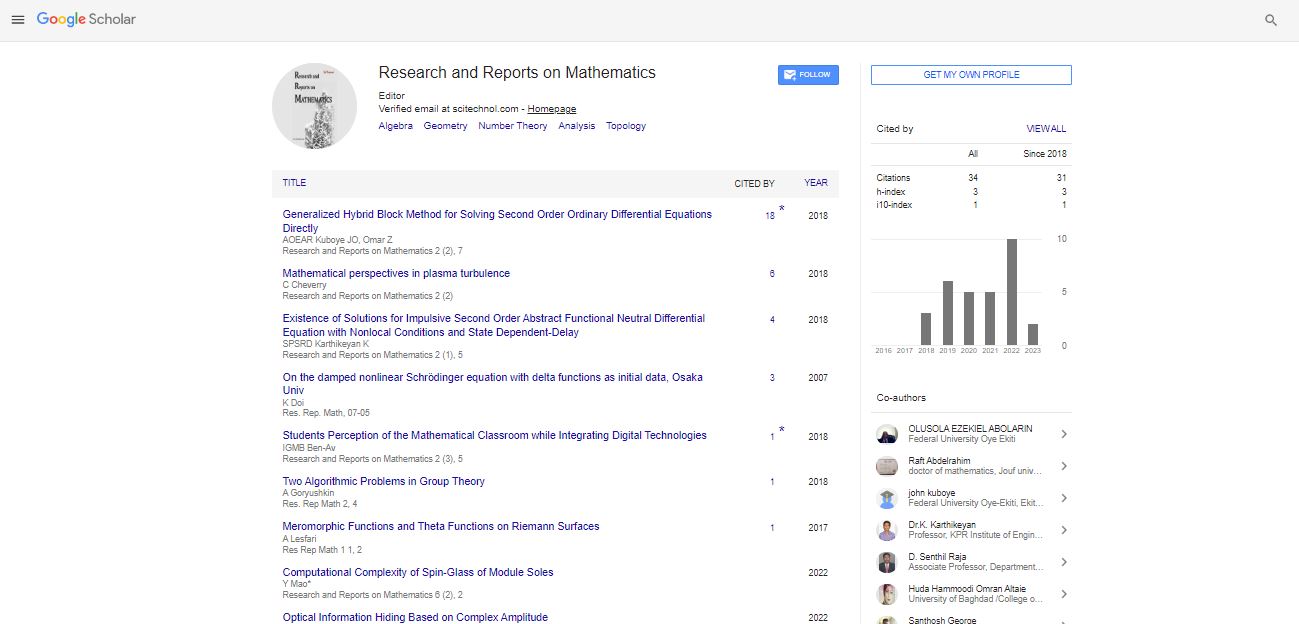Editorial, Res Rep Math Vol: 5 Issue: 9
Arithmetic in the Developing Brain: A Review of Brain Imaging Studies
Brain imaging research on tutorial fulfilment provide an thrilling window on experience-dependent cortical plasticity, as they enable us to apprehend how growing brains trade when kids accumulate culturally transmitted skills, such as studying or arithmetic. This contribution focuses on the mastering of arithmetic, i.e. the potential to add, subtract, multiply and divide symbolic entire numbers. This ability constitutes a principal aspect of the arithmetic curriculum in fundamental faculty and has a quintessential position in mathematical improvement for youngsters round the globe. There are massive person variations at the behavioral and neural tiers in this simple competence, even in maturity. On the different hand, continual deficits in gaining knowledge of arithmetic represent the hallmark of dyscalculia, a particular neurodevelopmental studying sickness that is characterised by means of life-long difficulties in calculation that are no longer only defined by means of mental disabilities, uncorrected sensory problems, intellectual or neurological issues or insufficient education (American Psychiatric Association, 2013). This contribution starts off evolved with a succinct dialogue of children’s arithmetic improvement and it’s helping cognitive competencies, as nicely as a short precis of intelligence imaging research in adults. These two sections are quick and solely grant a lens thru which we because of this talk about the handy neural records in children. We systematically assessment practical Genius imaging research in normally and atypically growing populations and supply an overview of connectivity studies. We additionally talk about structural talent imaging information that have correlated variability in arithmetic overall performance with man or woman variations in white and grey depend properties. This overview ends with challenges and high-quality troubles that must be regarded in future studies. Arithmetic Improvement is Characterised through Approach Change Decades of cognitive developmental lookup have investigated the acquisition of arithmetic and this improvement includes a alternate in the combine of techniques that are used to calculate the reply to a unique hassle. Already earlier than the begin of formal schooling, youngsters use counting to clear up easy sums. These counting techniques are at first completed with extra support, such as manipulatives or fingers, but progressively, teens execute these techniques besides exterior aids (verbal counting). The effectivity of these counting techniques will increase swiftly with grade, the place adolescents go from counting all units in their entirety to counting from the first (counting-on) or large (counting-on-larger) range. The repeated use of these counting routines approves teens to boost associations between troubles and their answers, arithmetic facts, which are saved in long-term memory. The acquisition of these records is essential due to the fact truth retrieval is extra environment friendly and it consumes much less working reminiscence than the extra cognitively stressful and error-prone procedures, such as counting. The availability of arithmetic records additionally permits adolescents to use these information to decompose issues into smaller problems, such as 7 + 8 =, 7 + 3 = 10, 10 + 5 = 15. These decomposition techniques commonly show up in troubles with large numbers (typically when they go 10) and, evidently, in multi-digit calculations. They are used extra regularly all through addition and subtraction − albeit greater often in subtraction than in addition however they are a great deal much less used in multiplication, in which truth retrieval is the most dominant method from an early factor on in development, i.e. 2nd grade. This is due to the fact multiplications are generally discovered via big (rote) coaching of the multiplication tables instead than by way of decomposing the hassle in its smaller sub-parts, as is regularly the case in subtraction. On the different hand, multiplication and addition are commutative operations (e.g. 6 × 4 = 4 × 6), in distinction to division and subtraction. This commutativity would possibly facilitate the formation of problem-answer associations in long-term reminiscence for multiplication and addition, for which cause they are greater frequently solved by using truth retrieval. Surprisingly little is recognized about the improvement of division; however the on hand proof suggests that its techniques comply with a relatively unique developmental trajectory. Because, to the nice of our knowledge, there are no developmental talent imaging research on division, this operation is no longer viewed further.
Abstract
Brain imaging research on tutorial fulfilment provide an thrilling
window on experience-dependent cortical plasticity, as they enable
us to apprehend how growing brains trade when kids accumulate
culturally transmitted skills, such as studying or arithmetic. This
contribution focuses on the mastering of arithmetic, i.e. the potential
to add, subtract, multiply and divide symbolic entire numbers. This
ability constitutes a principal aspect of the arithmetic curriculum in
fundamental faculty and has a quintessential position in mathematical
improvement for youngsters round the globe. There are massive person
variations at the behavioral and neural tiers in this simple competence,
even in maturity. On the different hand, continual deficits in gaining
knowledge of arithmetic represent the hallmark of dyscalculia, a
particular neurodevelopmental studying sickness that is characterised
by means of life-long difficulties in calculation that are no longer
only defined by means of mental disabilities, uncorrected sensory
problems, intellectual or neurological issues or insufficient education
(American Psychiatric Association, 2013). This contribution starts off
evolved with a succinct dialogue of children’s arithmetic improvement
and it’s helping cognitive competencies, as nicely as a short precis of
intelligence imaging research in adults. These two sections are quick
and solely grant a lens thru which we because of this talk about the
handy neural records in children.
 Spanish
Spanish  Chinese
Chinese  Russian
Russian  German
German  French
French  Japanese
Japanese  Portuguese
Portuguese  Hindi
Hindi 